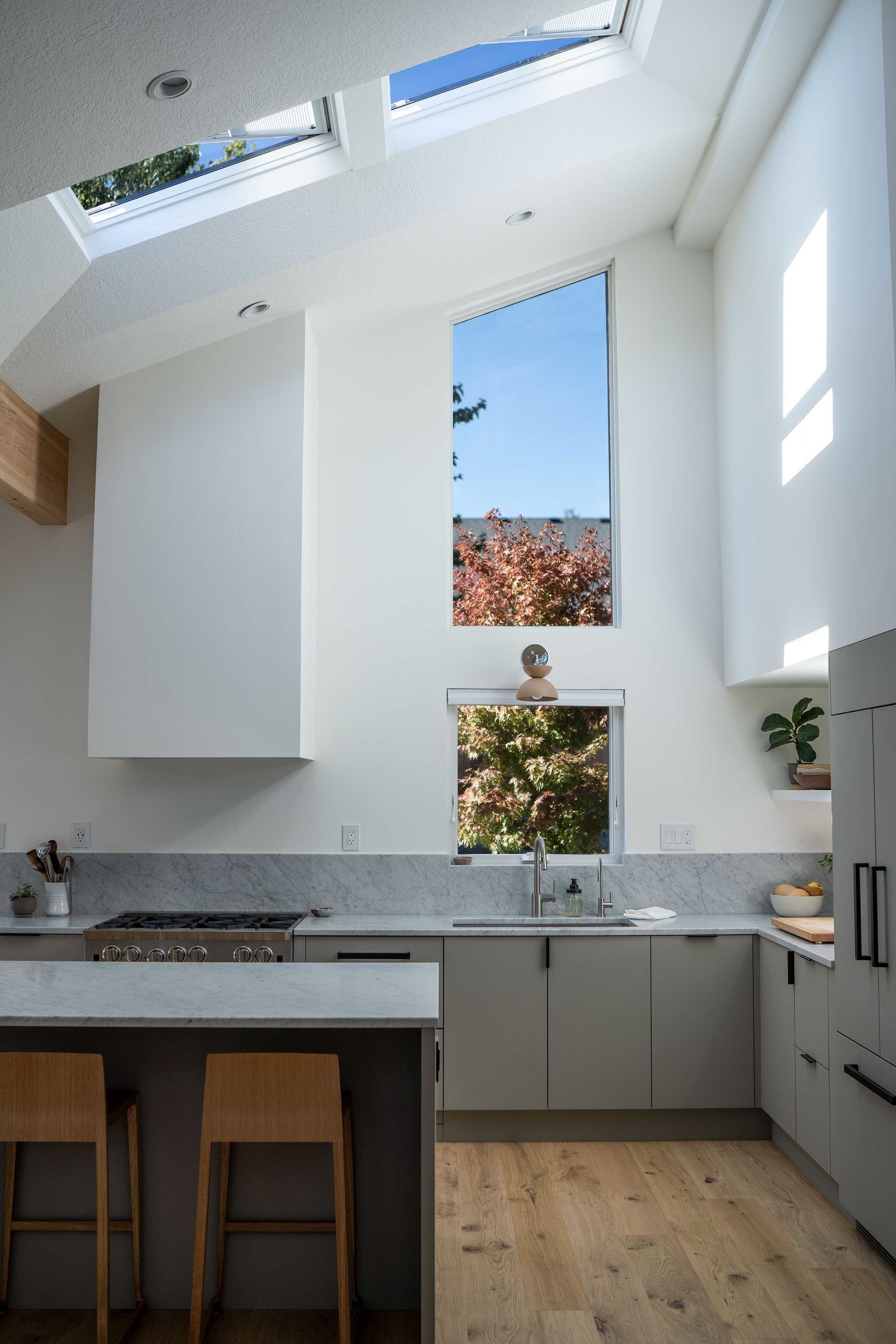Guest blog by Mickey Trescott, author of The Autoimmune Paleo Cookbook, who recently renovated her kitchen.
In modern times it is nearly impossible to get away from extensive time spent indoors. All of this time spent in buildings is against our need as humans to be in touch with our natural environment, which is necessary for good health. So what can we do about this?
Enter biophilic design. This refers to incorporating connection to the outdoors in our indoor environments, whether that is through natural ventilation and materials, natural lighting, outdoor views, landscaping, and interior designs that mimic nature (like using materials from nature, like stone and wood). Designing in this fashion not only is beautiful, but studies have indicated that using these elements may be able to mitigate some of the issues of spending so much time indoors.
Today, I’m going to discuss two issues common with interior spaces that can be addressed by incorporating skylights in interior spaces—natural light and ventilation.
Natural light
Light is one of the most powerful inputs we receive as humans. Our bodies rely on light exposure to set our biological clock, otherwise known as our circadian rhythm. This rhythm dictates things like our energy levels, when we feel sleepy, and how and when our bodies carry out critical biological processes.
Exposure to artificial light, especially in the blue-spectrum emanating from phones, computer screens, and most lights used in indoor spaces can seriously disrupt this rhythm by confusing this internal clock. Our ancestors were subject to a rhythm of light spectrum exposures throughout the day, from the highest exposure of blue light from bright sunlight in the early and middle parts of the day, down to predominantly more red spectrum from fire and candlelight used after dark.
Today, we’re exposed to blue light consistently throughout the day and sometimes even the night, confusing our internal clocks and often disrupting the body’s ability to find proper rhythms between high-energy parts of the day and deep, restorative sleep. Sleep is usually the first area those who find themselves off-track tend to notice issues, as exposure to blue light after dark suppresses the hormone melatonin, which is necessary to help us to fall asleep easily and get high-quality sleep.
Aside from limiting blue light exposure in the evening or night hours, one of the best ways to offset this phenomenon is to actually promote exposure to natural blue-spectrum light in the morning to midday hours, mimicking the intensity of blue light a person would be exposed to would they be spending all day outside, like our ancestors did. This intensity during the morning hours signals to the body to make the hormones that give us energy for our prime working hours of the day (and who doesn’t want more energy, right?).
Incorporating skylights into both our homes and our workplaces is a seamless way to allow this natural exposure to blue-spectrum light to happen, promoting the wellbeing of those who live and work in those spaces. Instead of needing to time outdoor activities to happen in the late morning or mid-day, which can be tricky due to work schedules, weather, or other conflicts, you can let the blue light come to you straight from the source through a skylight, just like nature intended.

Fresh air ventilation
The air we breathe is also an important factor keeping us healthy. According to the EPA’s report on the environment, Americans spend an average of 90% of time indoors, where air pollutants are 2 to 5 times higher than outside. The negative health consequences of persistent exposure to air pollutants ranges from mild irritation of the ears, nose, and throat to the development of chronic diseases like respiratory and heart disease, and even cancer in some cases, making this an issue we should all be concerned about.
So what is it about our interior spaces that could be causing this? Indoor air pollution can occur from combustion byproducts (such as appliances or smoking), pet hair and dander, mold, and volatile organic compounds (such as synthetic building materials, furnishings, and household cleaners). Depending on the way the building was built, how it is maintained, and the contents within concentration levels of these pollutants can vary widely.
It may seem like we’d be designing buildings to circumvent this issue, but the problem is actually getting worse. In an effort to promote energy efficiency, modern buildings are constructed incredibly “tight,” meaning there are very few gaps for air to pass into a home. This greatly increases the potential for and concentration of many indoor air pollutants in our interior environments, unless they are mitigated directly.
Designing buildings with materials that are less likely to promote air pollution and maintenance of elements that commonly cause issues (such as furnaces, stoves, and preventing water intrusion/leaks which can lead to mold) are one part of improving air quality. The second key to promoting healthy indoor air environments is providing a consistent, clean source of air to exchange within the building.
Incorporating skylights that can be opened into home designs, especially when paired with an active ventilation system (meaning that skylights open either at a certain time of day or when the air quality has deteriorated past a threshold) is an excellent way to ensure that the air in a space is consistently being monitored and exchanged. Because this is done automatically, you don’t need to remember to open a skylight, the system manages it for you, ensuring a steady supply of fresh air and ventilation of pollutants.

Skylight placement
Now that you’ve learned why skylights are an incredible solution to some of our modern issues regarding natural light and ventilation, you might be wondering what the best location will be for them! If you are looking to maximize these benefits, aim to use skylights in your primary living or working spaces. This might be an office or workspace, or the main areas of your house like a living room or kitchen.
Personally, I incorporated skylights in the design of my kitchen, as it functions as my primary workspace developing and photographing recipes for my cookbooks (and I also get an extra benefit of being able to ventilate those cooking smells, which can really stink up a house!). I love that my workspace is flooded with light during my prime working hours, and that the VELUX Active system is always monitoring the space for air quality and can automatically open the windows at any sign of high CO2, humidity, or temperatures.

Mickey Trescott is the author of three best-selling books, The Autoimmune Paleo Cookbook, The Autoimmune Wellness Handbook and The Nutrient-Dense Kitchen. She became an Autoimmune Protocol expert after being diagnosed with celiac and Hashimoto’s disease.








